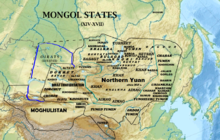Ordos Mongols
- View a machine-translated version of the Japanese article.
- Machine translation, like DeepL or Google Translate, is a useful starting point for translations, but translators must revise errors as necessary and confirm that the translation is accurate, rather than simply copy-pasting machine-translated text into the English Wikipedia.
- Consider adding a topic to this template: there are already 3,690 articles in the main category, and specifying
|topic=will aid in categorization. - Do not translate text that appears unreliable or low-quality. If possible, verify the text with references provided in the foreign-language article.
- You must provide copyright attribution in the edit summary accompanying your translation by providing an interlanguage link to the source of your translation. A model attribution edit summary is
Content in this edit is translated from the existing Japanese Wikipedia article at [[:ja:オルドス]]; see its history for attribution. - You may also add the template
{{Translated|ja|オルドス}}to the talk page. - For more guidance, see Wikipedia:Translation.
 Location of the Ordos Tumens | |
| Regions with significant populations | |
|---|---|
 China China | 123,000[1] (1982) |
| Languages | |
| Ordos dialect of Mongolian | |
| Religion | |
| Tibetan Buddhism and Atheism | |
| Related ethnic groups | |
| Mongols and Mongols in China | |
The Ordos (Mongolian Cyrillic: Ордос; Chinese: 鄂尔多斯部) are a Mongol subgroup that live in Uxin Banner, Inner Mongolia of China. Ordos literally means plural of Ordo.
The Three Tribes of Uriyangkhaid, Tümed in north Shanxi, Ordos Mongols in Ordos and north of Shaanxi extended southward beyond the Ming defense zone in the 14-15th centuries. Since 1510, the Ordos were ruled by descendants of Batumongke Dayan Khan.
The Ordos Mongols believe that they have been responsible for the shrine of Genghis Khan since their inception.[2] However, the modern place where mausoleum of Genghis Khan located is inhabited by the Shar Darkhads because the Ordos Mongols were forced to be resettled outside Ordos grasslands. Traditionally, Ordos territory is divided into 7 banners.
Their number reached 64,000 in 1950 and a possible current estimate of the Ordos people might be less than 100,000.[3]
References
- ^ "Mongolian, Peripheral". Ethnologue. Retrieved 2016-05-24.
- ^ Pegg, Carole (2001). Mongolian Music, Dance, & Oral Narrative: Performing Diverse Identities. University of Washington Press. p. 26. ISBN 9780295981123.
- ^ Janhunen, Juha (2006-01-27). The Mongolic Languages. Routledge. p. 193. ISBN 9781135796907.
- v
- t
- e
| Mongols |
| ||
|---|---|---|---|
| Oirats | |||
| Buryats | |||
| Other |
*Mongolized ethnic groups.**Ethnic groups of Mongolian origin or with a large Mongolian ethnic component.









